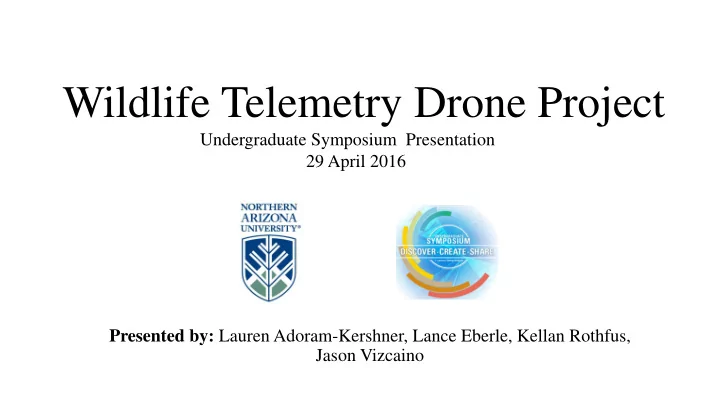

Wildlife Telemetry Drone Project Undergraduate Symposium Presentation 29 April 2016 Presented by: Lauren Adoram-Kershner, Lance Eberle, Kellan Rothfus, Jason Vizcaino
Overview 1. Project Description 2. Benchmarking 3. Customer Requirements 4. Design Process 5. Testing 6. Testing Results 7. Final Design 04/29/2016 Jason Vizcaino 2
Project Description Assist migratory studies of bats in remote Northern Arizona terrain. • Project objective- redesign Iteration 3 to produce a lightweight, collapsible, and strong drone frame that is easy to assembly. Sponsor/Client Interest: Dr. Michael Shafer has been conducting research in radio tracking systems. Figure 1: General Drone Operational Concept. Figure 2: SolidWorks Assembly of Iteration 3. 04/29/2016 Jason Vizcaino 3
Project Description Additional requirement of enclosing all electronics (except ESCs) was added after the initial project description. • Electronics must be able to connect to their corresponding components. Receiver Processing Board Flight Control Board (Raspberry Pi) (Pixhawk) Electronic Speed Controller Battery (ESC) Motors Figure 3: General Layout of Quadcopter Electronics. 04/29/2016 Jason Vizcaino 4
Benchmarking Figure 4: SolidWorks Assembly of Iteration 1. Figure 5: SolidWorks Assembly of Iteration 2. Iteration 2: Iteration 1: • • Electronics and propellers were not Redesigned frame; 3D printed components, compatible. lightweight base material, and carbon fiber • Extensive use of aluminum made arrow arms. frame too heavy. • Properly sized propellers. • Truss arm design maximized strength but had low torsional rigidity. 04/29/2016 Kellan Rothfus 5
Benchmarking Figure 6: SolidWorks Assembly of Iteration 3. Iteration 3: • 3D printed motor mounts and brackets. • Cross members between motor mounts provide torsional rigidity. • Refined landing gear using truss system. • Power system provides ~4 kg of thrust. • Too large and difficult to transport, over engineered. 04/29/2016 Kellan Rothfus 6
Benchmarking Research was conducted on existing frame components to aid in the design of Iteration 4. • Arms must be able to resist torsion from motors. • Double boom • Square wooden arm • Truss design • Motor mount designs were to be 3D printed. • Truss arm design • Double boom arm design Figure 7: Jimustanguitar Motor Mount. • Central hub must minimize volume for ease of transportation. • Stackable hub • Long central hub 04/29/2016 Kellan Rothfus 7
Customer Requirements From the project description and benchmarking data, the following customer requirements were developed: • Lightweight (80) • Strong/Rigid (80) • Collapsible (50) • Low Center of Gravity (30) • Aesthetics (10) The importance of each requirement is indicated by their associated weightings, which are out of 250 total points. 04/29/2016 Lauren Adoram-Kershner 8
Design Process Design A features stackable central hub and double boom arm design. It was completed before the enclosed electronics requirement was enacted. Flight controller shelf Processing board shelf Shelled to reduce weight Double boom arm configuration Battery compartment ESC platform Figure 8: SolidWorks Model of Design A. 04/29/2016 Lauren Adoram-Kershner 9
Design Process Design B features stackable hub and truss arm design to increase rigidity. It was completed after enclosed electronics requirement was enacted. Access to Processing board shelf threaded inserts Flight controller Access ports shelf Truss arm configuration ESC plug ESC wire recess Figure 9: SolidWorks Model of Design B. 04/29/2016 Lauren Adoram-Kershner 10
Testing Weight Measure weight of frame and ensure it is under 0.45 kg Power to Weight Measure net motor thrust and ensure it is twice the Ratio weight of the frame with electronics Durability Vertically drop drone from 0.5 m and check for damage Rigidity Conduct flight tests and ensure arms can handle torque of motors Storage Volume Collapse drone and place into 30 L backpack Construction Construct drone without use of diverse tool set Cost Calculate cost of used materials, must total under $250 04/29/2016 Lance Eberle 11
Testing Results Weight Drone frame weighs 0.592 kg Power to Weight Net thrust of motors is 4 kg and with electronics Ratio drone weighs 1.45 kg resulting in a Power to Weight ratio of 2.76 Durability No damage sustained from a 0.5 m drop Rigidity Arms are sufficiently rigid during flight Storage Volume Drone fits into 30 L backpack Construction Drone only requires one hex key to construct Cost Drone cost $93.86 to construct (not including 3D printing, or electrical component costs) 04/29/2016 Lance Eberle 12
Final Design Prototyping of Design B showed areas for tolerance and design intelligence improvements: • External port/mount for flight controller power button • Internal ports to allow battery harness to connect to ESCs Figure 10: SolidWorks Assembly of Final Design. 04/29/2016 Lance Eberle 13
Final Design Six different lengths of carbon fiber arrow One length of carbon fiber arrow section sections 17 separate 3D printed parts Five 3D printed parts; including central hub All carbon fiber arrows are epoxied into 3D Only permanent connections are arrow inserts; printed junctions; completely rigid collapsible Large propeller clearance Propellers closer to frame; more maneuverable Figure 11: SolidWorks Arm Assembly of Final Design; Exploded View. 04/29/2016 Lance Eberle 14
Questions? Figure 12: SolidWorks Assembly of Final Design; Exploded View.
References [1] M. W. Shafer, “An Unmanned Aerial Radio Tracking System for Monitoring Small Wildlife Species,” unpublished. [2] W. Arjana , et al, “Wildlife Telemetry Drone,” unpublished. [3] Jimustanguitar. (2015, May 1). 3D Printed & Carbon Fiber QuadCopter - My Own Design! [Online]. Available: http://forum.flux3dp.com/t/3d-printed-carbon-fiber-quadcopter-my-own-design/430. Accessed: 7 Oct. 2015. [4] D. Windestål. (2012 July 19). The Tricopter V2.6HV. [Online]. Available: http://rcexplorer.se/projects/2012/07/the- tricopter-v2-6hv/. Accessed: 7 Oct. 2015. [5] Jimustanguitar. (2015, June 6). 3D Printed & Carbon Fiber QuadCopter [Online]. Available: http://www.instructables.com/id/3D-Printed-Carbon-Fiber-QuadCopter/. Accessed: 7 Oct. 2015. [6] HiModel. (2014, April 24). 12mm Plastic Motor Mount for Multi-rotor Aircraft Type B 123-004. [Online]. Available: http://www.himodel.com/m/electric/12mm_Plastic_Motor_Mount_for_Multi-rotor_Aircraft_Type_B_123-004.html. Accessed: 7 Oct. 2015. [7] Octovir. (2011, August 14). Carbon Fiber Arducopter/Quadcopter Frame by Octovir. [Online]. Available: http://www.thingiverse.com/thing:10731. Accessed: 7 Oct. 2015. [8] Flite Test Store. (2014, July 14). ElectroHub. [Online]. Available: http://store.flitetest.com/electrohub-quadcopter-kit/. Accessed: 6 Oct. 2015.
Recommend
More recommend